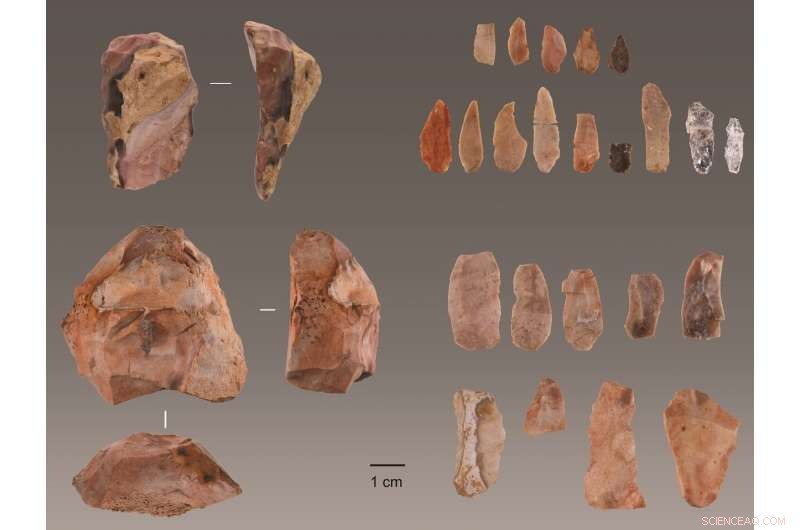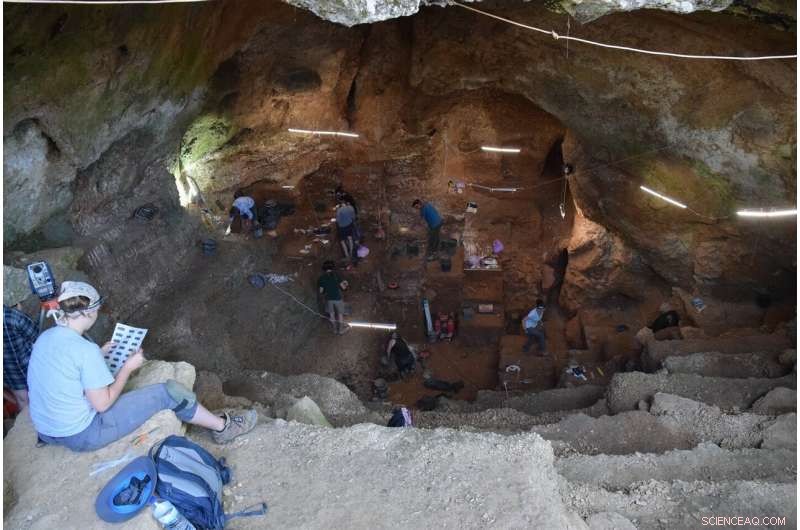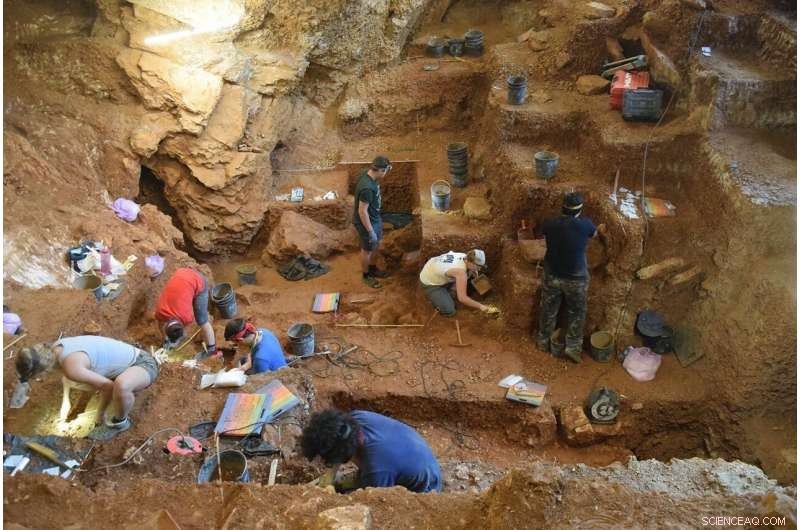
Herramientas descubiertas en Lapa do Picareiro en el centro de Portugal. Crédito:Jonathan Haws.
Los humanos modernos llegaron a la parte más occidental de Europa 41, 000—38, 000 años atrás, como 5, 000 años antes de lo que se conocía anteriormente, según Jonathan Haws, Doctor., profesor y presidente del Departamento de Antropología de la Universidad de Louisville, y un equipo internacional de investigadores. El equipo ha revelado el descubrimiento de herramientas de piedra utilizadas por los humanos modernos que datan de un período de tiempo anterior en un informe publicado esta semana en la revista. procedimientos de la Academia Nacional de Ciencias .
Las herramientas, descubierto en una cueva llamada Lapa do Picareiro, ubicado cerca de la costa atlántica del centro de Portugal, vincular el sitio con hallazgos similares de toda Eurasia a la llanura rusa. El descubrimiento respalda una rápida dispersión hacia el oeste de los humanos modernos a través de Eurasia unos pocos miles de años después de su primera aparición en el sureste de Europa. Las herramientas documentan la presencia de humanos modernos en la Europa más occidental en un momento en el que anteriormente se pensaba que los neandertales estaban presentes en la región. El hallazgo tiene ramificaciones importantes para comprender la posible interacción entre los dos grupos humanos y la desaparición final de los neandertales.
"La cuestión de si los últimos neandertales supervivientes en Europa han sido reemplazados o asimilados por los humanos modernos entrantes es una cuestión de larga data, problema no resuelto en paleoantropología, "dijo Lukas Friedl, antropólogo de la Universidad de West Bohemia en Pilsen, República Checa, y colíder del proyecto. "Las fechas tempranas de las herramientas de piedra auriñacienses en Picareiro probablemente descartan la posibilidad de que los humanos modernos llegaran a la tierra desprovista de neandertales durante mucho tiempo, y eso en sí mismo es emocionante ".
Hasta ahora, la evidencia más antigua de humanos modernos al sur del río Ebro en España provino del Bajondillo, un sitio de cueva en la costa sur. El descubrimiento de taburetes de piedra caracterizados como auriñacienses, tecnología asociada con los primeros humanos modernos en Europa, en un contexto estratigráfico seguro en Picareiro proporcionan evidencia definitiva de la llegada humana moderna temprana.
"Bajondillo ofreció evidencia tentadora pero controvertida de que los humanos modernos estaban en el área antes de lo que pensábamos, "Haws dijo." La evidencia en nuestro informe definitivamente apoya las implicaciones de Bajondillo para una llegada humana moderna temprana, pero aún no está claro cómo llegaron aquí. La gente probablemente emigró a lo largo de ríos que fluían de este a oeste en el interior, pero todavía es posible una ruta costera ".
"La propagación de humanos anatómicamente modernos por Europa hace muchos miles de años es fundamental para nuestra comprensión de dónde venimos como una especie ahora global". "dijo John Yellen, director del programa de arqueología y arqueometría de la National Science Foundation, que apoyó el trabajo. "Este descubrimiento ofrece nueva evidencia significativa que ayudará a dar forma a futuras investigaciones que investiguen cuándo y dónde llegaron los humanos anatómicamente modernos a Europa y qué interacciones pueden haber tenido con los neandertales".

Vista de Lapa do Picareiro mirando desde la entrada. Crédito:Jonathan Haws
La cueva de Picareiro ha estado bajo excavación durante 25 años y ha producido un registro de ocupación humana durante los últimos 50, 000 años. Un equipo de investigación internacional del Centro Interdisciplinario de Arqueología y Evolución del Comportamiento Humano (ICArEHB) en Faro, Portugal, está investigando la llegada de los humanos modernos y la extinción de los neandertales en la región.
El proyecto está liderado por Haws, Michael Benedetti de la Universidad de Carolina del Norte en Wilmington, y Friedl, en colaboración con Nuno Bicho y João Cascalheira de la Universidad de Algarve, donde se encuentra ICArEHB, y Telmo Pereira de la Universidad Autónoma de Lisboa.
Con el apoyo de las subvenciones de la Fundación Nacional de Ciencias de EE. UU. A Haws y Benedetti, el equipo ha descubierto ricos depósitos arqueológicos que incluyen herramientas de piedra en asociación con miles de huesos de animales de la caza, actividades de carnicería y cocina.
Sahra Talamo de la Universidad de Bolonia, Italia, y el Instituto Max Planck de Antropología Evolutiva en Leipzig, Alemania, joined the research team to determine the age of the early modern human and Neanderthal occupations. She used state-of-the-art bone pretreatment and accelerator mass spectrometry (AMS) to date the bones that show evidence of butchery cut marks and intentional breakage by humans to extract bone marrow, a highly prized and nutritious food consumed by ancient people. The dating results place the modern human arrival to the interval between 41, 000 and 38, Hace 000 años. The last Neanderthal occupation at the site took place between 45, 000 and 42, Hace 000 años.
"The radiocarbon results from Lapa do Picareiro are not only very precise in terms of the dating method, but also demonstrate the meticulous work of the archeologists at the site, " Talamo said. "The importance of collaboration between the radiocarbon specialist and the archaeologists is essential in order to obtain an accurate chronology like in the case of Picareiro."
Spatial analysis of high-resolution three-dimensional data confirmed the precise stratigraphic relationships between artifacts and radiocarbon samples and revealed discrete layers of occupation at the site.
"Analysis of high-resolution spatial data is crucial for documenting and observing lenses of human occupation and reconstructing occupational patterns, especially in cave environments where complex formation processes exist, " said Grace Ellis, un doctorado student at Colorado State University studying landscape archaeology and ancient settlement patterns.

View of the excavation of the early modern human (foreground) and Neanderthal layers (background) of Lapa do Picareiro. Credit:Jonathan Haws
This was backed up by artifact refitting that showed the stone tools were not moved through post-depositional processes.
"Refitting is a task that requires a lot of time and patience, and in this case, it really was worthwhile because the results verified the geospatial observations, " said Pereira, an archaeologist who specializes in stone technology.
While the dates suggest that modern humans arrived after Neanderthals disappeared, a nearby cave, Oliveira, has evidence for Neanderthals' survival until 37, Hace 000 años. The two groups may have overlapped for several thousand years in the area.
"If the two groups overlapped for some time in the highlands of Atlantic Portugal, they may have maintained contacts between each other and exchanged not only technology and tools, but also mates. This could possibly explain why many Europeans have Neanderthal genes, " said Bicho, director of ICArEHB.
"Besides genetic and archeological evidence, high-resolution temporal context and fossil evidence across the continent is crucial for answering this question. With the preserved key layers dated to the transitional period, we are now awaiting human fossils to tell us more about the nature of the transition, " Friedl said.
Despite the overlap in dates, there does not appear to be any evidence for direct contact between Neanderthals and modern humans. Neanderthals continued to use the same stone tools they had before modern humans arrived, bringing a completely different stone technology.
"Differences between the stone tool assemblages dated before and after about 41, 000 years ago are striking at Picareiro, " said Cascalheira, an ICArEHB board member and specialist on stone tool technology. "Older levels are dominated by quartzite and quartz raw materials and marked by the presence of Levallois technology, a typical element of Neanderthal occupations in Europe. Aurignacian levels, por otra parte, are dominated by flint and the production of very small blades that were likely used as inserts in arrow shafts for hunting."
Flint also was used to make tools for butchering animals such as red deer, ibex and possibly rabbits. The team recovered a few red deer canine teeth, often used as personal adornments, but so far these do not show traces of manufacturing jewelry.
"The bones from Lapa do Picareiro make up one of the largest Paleolithic assemblages in Portugal, and the preservation of these animal bones is remarkable, " said Milena Carvalho, un doctorado candidate at the University of New Mexico and ICArEHB researcher studying the diets and paleoecology of Neanderthals and modern humans. "The collection will provide tremendous amounts of information on human behavior and paleoecology during the Paleolithic and we will be studying it for decades."
The cave sediments also contain a well-preserved paleoclimatic record that helps reconstruct environmental conditions at the time of the last Neanderthals and arrival of modern humans.
"We studied changes in the size of limestone clasts and the chemistry of muddy fine sediment filling the cave to understand the paleoclimatic context for the transition, " Benedetti said. "Our analysis shows that the arrival of modern humans corresponds with, or slightly predates, a bitterly cold and extremely dry phase. Harsh environmental conditions during this period posed challenges that both modern human and Neanderthal populations had to contend with."
The cave itself has an enormous amount of sediment remaining for future work and the excavation still hasn't reached the bottom.
"I've been excavating at Picareiro for 25 years and just when you start to think it might be done giving up its secrets, a new surprise gets unearthed, " Haws said. "Every few years something remarkable turns up and we keep digging."